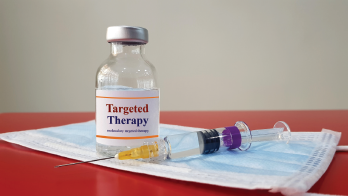
joel bubble ben / shutterstock.com
EULAR 2020 e-CONGRESS—In what speakers at the European e-Congress of Rheumatology described as the first treat-to-target and tight control (T2T/TC) strategy trial in axial spondyloarthritis (AxSpA), researchers found such a strategy has both health and financial benefits.
In the year-long study—called TICOSPA—centers were randomized to apply either a T2T/TC strategy or care left to the discretion of their rheumatologist, with 80 patients with AxSpA randomized to each arm, and 72 in each arm seen by researchers through to the study’s end. To be included in the study, patients must have had a diagnosis of predominant axial spondyloarthritis according to both the axial ASAS (Assessment of SpondyloArthritis International Society) criteria and the opinion of the treating rheumatologist, as well as have active disease (defined as an Ankylosing Spondylitis Disease Activity Score [ASDAS] of at least 2.1) and have been suboptimally treated with at least two non-steroidal anti-inflammatory drugs (did not have to be simultaneous) in the previous year.

Dr. Molto
Anna Molto, MD, PhD, a rheumatologist and researcher at Cochin Hospital, Paris, said rheumatologists approached patients in the treat-to-target group with a pre-defined strategy that included a treatment recommendation produced by an algorithm and treatment intensification until patients reached an ASDAS less than 2.1. Patients in the usual care group were managed according to physician discretion. Physicians using usual care were blinded to the treat-to-target strategy, with separate study meetings conducted. The study included 18 centers in France, Belgium and The Netherlands.1
The main outcome was a significant improvement of at least 30% in the ASAS Health Index (ASAS-HI), a measure of overall health among ankylosing spondylitis patients. Other parameters were assessed as secondary outcome measures.
Researchers saw no statistically significant difference between the two groups in the proportion of patients achieving 30% improvement in the ASAS-HI, although 11% more patients in the treat-to-target group reached that outcome—47% compared with 36% in the usual care group.

Dr. van der Heijde
Investigators did see significant improvements in several other domains in the treat-to-target group compared with those in the usual care group. These included changes in the ASDAS low-disease activity measure and the disease improvement measures ASAS40 and ASAS20, as well as the Bath Ankylosing Spondylitis Disease Activity Index (BASDAI) and the BASDAI 50. No significant improvements were seen in other measures, including the ASDAS inactive disease measure, the ASDAS partial remission measure and the physician global assessment.
The treat-to-target approach was found to be cost effective, with an incremental cost-utility ratio of €19,430 (or approximately $22,900 U.S.) per quality-adjusted life year.
Dr. Molto acknowledged the best outcome measure to examine in a comparison of treatment strategy is structural damage, but a trial with such an endpoint would take five to 10 years. The outcome chosen was intended to give a broad picture of the patient’s overall condition, she said.
“The main strength of this study was the decision to choose a primary outcome which was different from the target,” Dr. Molto said. “In previous studies in rheumatology for treat-to-target in rheumatoid arthritis and psoriatic arthritis, both the target and the outcome were based on the same domain—on disease activity. Here, we wanted to show an improvement—significant improvement—in another domain of the disease, quality of life, while targeting inflammation and disease activity.”

